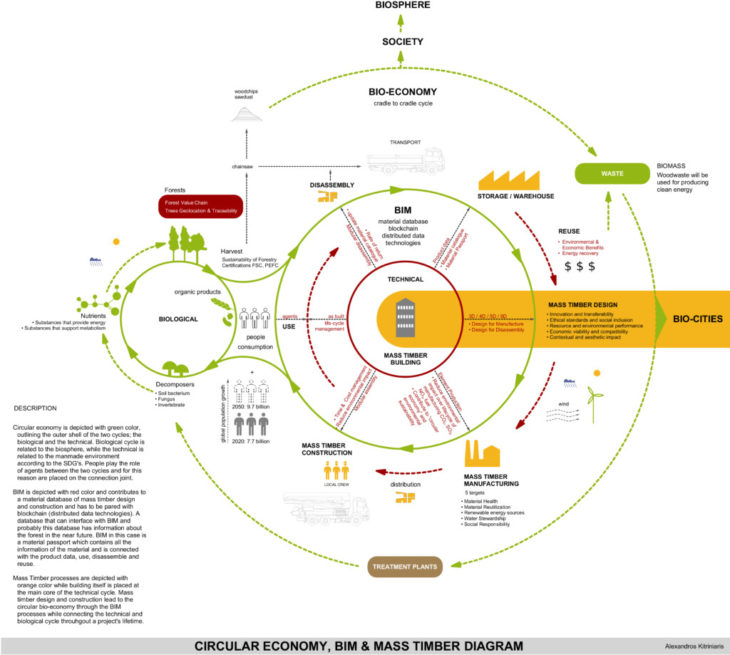Circular Economy – BIM & Mass Timber Diagram
The United Nations (UN) Sustainable Development Goals (SDGs), launched in 2015, ‘are the blueprint to achieve a better and more sustainable future for all’ and they look to ‘address the global challenges we face, including those related to poverty, inequality, climate, environmental degradation, prosperity, and peace and justice’ (United Nations 2018). At the same time, the United Nations Global Compact (2018) argued that meeting these goals ‘will take an unprecedented effort by all sectors in society’ but emphasised that ‘business has to play a very important role in the process.’
Vale and Vale (2009:10) discuss the two models for portraying the meaning of sustainability; the ‘weak model’ and the ‘strong model’ of sustainability.
According to Vale and Vale (2009:10) in the weak model of sustainability, the three main components of sustainable development, the environment, human society and the economy are represented by three intersecting circles of equal size and values. In the weak model of sustainability, the three main components are portrayed as competing interests so that degradation of one can be compensated for by improvement in another.
In the strong sustainability model, as explained by Vale and Vale (2009:10) the environment is considered as a circle in which society (as a base for human activities) is set (Figure 2.2). In this model, the environment is considered as the main foundation, which strongly exerts influences on society, culture, and all their subsectors such as the economy, architecture, politics, art etc. (Figure2.2). As a reason to make an effort to move towards environmental conservation through sustainable development as a priority policy, it could be conjectured that “if we destroy the environment, which sustains us and provides our air, water, and food, then we will destroy human society; if we destroy human society; we will certainly destroy the economy” (Vale and Vale, 2009:11).
The role of Mass Timber in the circular economy is closely related to the construction industry and BIM as well as to the technical and biological cycle, by placing human and animal consumption at the merging point of these cycles. In order to be integrated into the circular economy and bio-economy, a mass timber building should be designed to assemble, dissembled and reassembled, stored, and transformed to a new use if needed. BIM bridges this process as helping to catalog the lifespan of building components as well as the controls the distribution chain between all the steps from harvesting and collecting timber up to reuse and recontruction.

CIRCULAR ECONOMY, BIM & MASS TIMBER DIAGRAM
Circular economy is depicted with green color, outlining the outer shell of the two cycles; the biological and the technical. The biological cycle is related to the biosphere, while the technical is related to the manmade environment according to the SDG’s. People play the role of agents between the two cycles and for this reason are placed on the connection joint.
BIM is depicted with red color and contributes to a material database of mass timber design and construction and has to be pared with blockchain (distributed data technologies). A database that can interface with BIM and probably this database has information about the forest in the near future. BIM in this case is a material passport that contains all the information of the material and is connected with the product data, use, disassemble and reuse.
Mass Timber processes are depicted with orange color while building itself is placed at the main core of the technical cycle. Mass timber design and construction lead to the circular bio-economy through the BIM processes while connecting the technical and biological cycle throughout a project’s lifetime.
—
Circular Economy Mass Timber & BIM Modeling of the Suma House is a project of IaaC, Institute for Advanced Architecture of Catalonia developed at Master in Mass Timber Design in 2021/2022 by Student: Alexandros Kitriniaris. Faculty: Michael Salka. Course: Tools 1